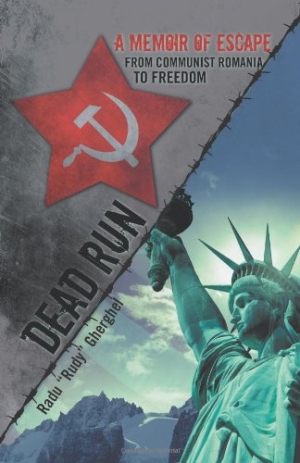Dead Run
A Memoir of Escape from Communist Romania to Freedom
Radu “Rudy” Ghergel was born into a society where government oppression was the norm. For him, the solution was clear: escape. His personal perils and his ultimate triumph are described in gripping detail in Dead Run.
In this memoir, Ghergel recounts that his native country of Romania was a relatively stable, small European kingdom before World War II. His father was killed in the war, which ended with Soviet occupation. His grandfather, a religious leader, and his uncle, an official to the former king, both suffered retaliation under the Communist regime.
“So it was that our own family came to be counted as one of the millions with relatives who disappeared into the Soviet maw, Stalin’s purges, which had begun as early as the 1930s, continued to sweep up party members, undesirables, gypsies and Jews,” Ghergel writes. “No one was safe from the KGB and the secret police forces of satellite countries like Romania.”
The one ray of hope in the boy’s life was his grandmother’s secret: late at night, they listened to broadcasts of Radio Free Europe. As the government became more secretive and tyrannical, these broadcasts and the country that produced them became a tiny beacon for the youngster.
After obtaining a master’s degree in chemical engineering, Ghergel was forced into a grim, hopeless job, working in a factory where poisonous powders were used to produce plastic raincoats. His rage at the system grew as he saw party-appointed managers arrogantly oppressing the virtual slaves under them, while the factory churned out shoddy products. Desperate, he resolved to get to America. Allowed to visit Yugoslavia for a family funeral, Ghergel ran across the border into Italy, dodging bullets, then crossed the perilous French Alps, and at last obtained a visa for the United States through a charitable organization. He has lived and prospered in the United States since 1967.
Ghergel writes with a secure grasp of both grammatical and idiomatic English (he points out that his facility for languages aided his escape). Despite the book’s unusual setting, the clear first-person viewpoint allows the reader to identify with Ghergel’s plight. His small book proceeds in a logical chronology and includes a brief epilogue and black-and-white photographs of documents that led to his arrival in America. The front cover effectively depicts the Statue of Liberty on one side and the Soviet hammer and sickle on the other, separated by a symbolic line of barbed wire. There is a color photo and blurb about the author on the back, along with a brief description of the book’s contents.
Had Ghergel wished to do so, he could have written a broader, lengthier history by weaving his saga into an international panorama with more in-depth research. However, what he has produced—a simple account of individual determination and idealism––is undoubtedly personally satisfying. One suspects Dead Run was created more than anything as a legacy for the author’s happy American family—his wife, two children, and six grandchildren.
Reviewed by
Barbara Bamberger Scott
Disclosure: This article is not an endorsement, but a review. The publisher of this book provided free copies of the book and paid a small fee to have their book reviewed by a professional reviewer. Foreword Reviews and Clarion Reviews make no guarantee that the publisher will receive a positive review. Foreword Magazine, Inc. is disclosing this in accordance with the Federal Trade Commission’s 16 CFR, Part 255.

